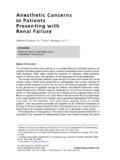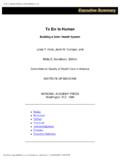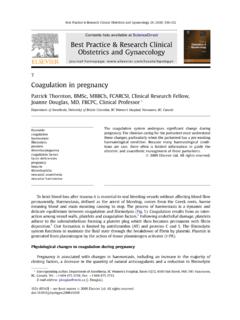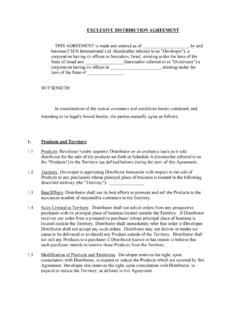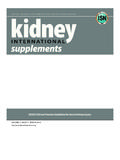Transcription of Surgery in the Patient with Renal Dysfunction - CSEN
1 Surgery in the Patient with Renal Dysfunction a b, Dean R. Jones, MD, FRCPC , Lee, MD, PhD *. KEYWORDS. Chronic kidney disease Acute kidney injury Renal failure Renal protection Preoperative evaluation Millions of patients with Renal Dysfunction have Surgery each year. The social and financial impact on the health care system is Preoperative evaluation should attempt to reduce morbidity and mortality and improve quality in this complex Patient population. Renal Dysfunction represents a spectrum of disease with potentially far-ranging consequences on surgical and anesthetic management due to not only the underlying disease processes but also from the intervening medical and surgical therapies. Furthermore, optimization of the Patient with Renal Dysfunction needs to not only consider the preexisting Renal function but also the potential risk of acute kidney injury (AKI) in the perioperative setting. In this context, the goal of this review is to focus on perioperative evaluation and optimization of care in surgical patients who have Renal Dysfunction .
2 Two different sections are presented. The first section focuses on definitions and the epidemiology of chronic kidney disease (CKD), end-stage Renal disease (ESRD), and AKI. The surgical risk factors for AKI are also reviewed. The second section focuses on an approach to preoperative evaluation, with particular emphasis on potential areas of conflict between the primary care physician or nephrologist, surgeon, and anesthesi- ologist. Recent research findings on perioperative Renal protection strategies are also reviewed. Renal Dysfunction . Chronic kidney Disease CKD as defined in 2002 by the kidney Disease Outcomes Quality Initiative (K/DOQI) of the National kidney Foundation is either kidney damage or decreased kidney function This article originally appeared in Medical Clinics of North America, Volume 93, Issue 5. This work was supported solely by the Intramural Research Fund of the Department of Anesthesiology at Columbia University.
3 A Department of Anesthesiology, Columbia University, PH 5-133, 622 West 168th Street, New York, NY 10032, USA. b Department of Anesthesiology, Anesthesiology Research Laboratories, Columbia University, P&S Box 46 (PH-5), 630 West 168th Street, New York, NY 10032-3784, USA. * Corresponding author. E-mail address: ( Lee). Anesthesiology Clin 27 (2009) 739 749. 1932-2275/09/$ see front matter 2009 Elsevier Inc. All rights reserved. 740 Jones & Lee for 3 or more Proteinuria or abnormalities in imaging tests are markers for kidney damage and a reduction in glomerular filtration rate (GFR) is a marker for decreased kidney ESRD is a government-derived administrative term that only indicates chronic treatment by dialysis or transplantation. It does not refer to a specific degree of kidney The National kidney Foundation classifies CKD based on pathology: Diabetic glomerulosclerosis Glomerular diseases (primary or secondary).
4 Vascular diseases (including hypertension and microangiopathy). Tubulointerstitial diseases (including obstructive or reflux nephropathy). Cystic diseases Diseases in Renal transplant recipients (rejection, drug toxicity, recurrence of disease). A GFR of less than 60 mL/ m2 is considered the threshold for GFR. varies with sex, age, and body size, and is typically estimated with calculations based on serum creatinine (SCr) Stevens and colleagues4 review the limitations of the SCr-based Cockcroft-Gault formula and the Modification of Diet in Renal Disease (MDRD) equation. Proximal tubular cells in the kidney secrete creatinine and therefore creatinine clearance surpasses GFR. However, in the steady state SCr is related to the reciprocal of As shown in Table 1, there are 5 different stages of kidney failure is defined as either GFR less than 15 mL/ m2 or a need for dialysis or Renal transplantation. Acute kidney Injury There are many different definitions for an acute change in Renal function.
5 The term acute Renal failure (ARF) has been supplanted by the term AKI encompasses the entire range of ARF from small changes in SCr to loss of function requiring dialysis. In an effort to standardize the classification of AKI, in 2004 the Acute Dialysis Quality Initiative (ADQI) Group proposed the RIFLE As shown in Fig. 1, RIFLE stands for Risk of Renal Dysfunction ; Injury to the kidney ; Failure of kidney function; Loss of kidney function; and End-stage kidney disease. It relies on measurement of GFR or SCr and urine output (UO) to classify the severity of ARF. Since their initial publication, the RIFLE criteria have been validated in numerous studies of intensive care unit (ICU), postsurgical, and hospital patients as independent predictors of 9 In 2007. the Acute kidney Injury Network (AKIN) proposed a modification to the RIFLE As shown in Table 2, the AKIN definition considers 3 different stages of AKI, adds a 48-hour time frame for the diagnosis of AKI, and changes the criteria for Risk,''.
6 Table 1. Stages of chronic kidney disease Stage Description GFR (mL/ m2). 1 kidney damage with normal or increased GFR R90. 2 kidney damage with mild decrease in GFR 60 89. 3 Moderate decrease in GFR 30 59. 4 Severe decrease in GFR 15 29. 5 kidney failure <15 (or dialysis). Surgery in the Patient with Renal Dysfunction 741. Fig. 1. Proposed classification scheme for acute Renal failure (ARF). The classification system includes separate criteria for creatinine and output (UO). A Patient can fulfill the criteria through changes in serum creatinine (SCreat) or changes in UO, or both. ARF, acute Renal failure; GFR, glomerular filtration rate. (From Bellomo R, Ronco C, Kellum JA, et al. Acute Renal failure definition, outcome measures, animal models, fluid therapy and information technology needs: the Second International Consensus Conference of the Acute Dialysis Quality Initiative (ADQI) Group. Crit Care 2004;8(4):R204 12; with permission.)
7 Or Stage 1 AKI, to include patients with increases in SCr level of greater than or equal to mg/dL ( mmol/L). In a 5-year analysis of more than 120,000 ICU admis- sions in Australia, investigators found no significant differences in the predictive ability of the RIFLE criteria compared with the AKIN Despite their use in current definitions of AKI, SCr and UO are not the ideal markers for AKI and significant research efforts are underway to identify biomarkers of Potential biomarkers of AKI include neutrophil gelatinase-associated lipocalin (NGAL), cystatin C, and AKI can be classified according to prerenal, Renal , and postrenal Perioper- atively the most common cause of AKI is secondary to acute tubular necrosis (ATN).12. A study in ICU patients found the most common causes of AKI were septic shock, major Surgery , cardiogenic shock, hypovolemia, and drug-induced Surgical Risk Factors for AKI. patients with kidney disease may present for a wide variety of surgical procedures.
8 Access for dialysis is the most common procedure followed by procedures for periph- eral vascular disease, coronary artery disease, and kidney Overall, the risk of AKI in surgical patients has been estimated to be approximately 1%.15 However, certain Patient populations are at much higher risk. Factors identified as increasing the risk of AKI include age, past history of kidney disease, left ventricular ejection fraction less than 35%, cardiac index less than L/min/m2, hypertension, peripheral vascular disease, diabetes mellitus, emergency Surgery , and type of The highest risk surgeries include coronary artery Surgery , cardiac valve Surgery , aortic aneurysm Surgery , and liver transplant 18 The literature is difficult to evaluate given the many different definitions of AKI, but rates of AKI or 742 Jones & Lee Table 2. Classification/staging system for AKIa Stage Serum Creatinine Criteria Urine Output Criteria 1 Increase in serum creatinine of more than or equal to Less than mL/kg/h for mg/dL (R mmol/l) or increase to more than or more than 6 h equal to 150% to 200% ( to 2-fold) from baseline 2b Increase in serum creatinine to more than 200% to Less than mL/kg/h for 300% (>2- to 3-fold) from baseline more than 12 h 3c Increase in serum creatinine to more than 300% Less than mL/kg/h for (>3-fold) from baseline (or serum creatinine of more 24 h or anuria for 12 h than or equal to mg/dL [R 354 mmol/l] with an acute increase of at least mg/dL [44 mmol/l]).
9 A Modified from the RIFLE (Risk, Injury, Failure, Loss, and End-stage kidney disease) criteria. The staging system proposed is a highly sensitive, interim, staging system and is based on recent data indicating that a small change in serum creatinine level influences outcome. Only 1 criterion (creatinine level or urine output) has to be fulfilled to qualify for a stage. b 200% to 300% increase 5 2- to 3-fold increase. c Given wide variation in indication and timing of initiation of Renal replacement therapy (RRT). Individuals who receive RRT are considered to have met the criteria for stage 3 irrespective of the stage they are in at the time of RRT. Adapted from Mehta RL, Kellum JA, Shah SV, et al. Acute kidney Injury Network: report of an initiative to improve outcomes in acute kidney injury. Crit Care 2007;11(2):R31; with permission. need for dialysis range from 3% to 5% for cardiac Surgery with cardiopulmonary bypass to more than 50% for emergency abdominal aortic aneurysm Perioperative Morbidity of kidney Disease The United Stated Renal Data System (USRDS) collects data on the ESRD population in the United The 2007 USRDS report estimates that approximately 15% of the general population has They also estimate that all-cause hospitalization rates are 3 times higher for patients with CKD and that rates of hospitalization due to AKI are approximately 6 times higher for patients with CKD.
10 The presence of CKD increases the rates of morbidity and mortality for several different surgical procedures. Investigators found estimated GFR (eGFR) calculated by the MDRD equation to be an independent predictor of mortality after coronary artery bypass graft Surgery (CABG).19 The mean eGFR was mL/ m2 for survivors compared with mL/ m2 in the patients who Similar findings correlating eGFR with increased morbidity and mortality have also been pub- lished for elective major vascular Surgery , hip fracture and repair, and endovascular aortic aneurysm 23. A review found the overall mortality rate from AKI between 1956 and 2003 was comparatively unchanged at approximately 50%.24 AKI during the perioperative period had an even poorer prognosis with mortality rates of 64% to 83% depending on the surgical ,25 Even small changes in SCr correlate with a significant increase in the risk of death. In 1 study, patients with SCr increases of to mg/dL had a 70%.
